Designation of four Marine Protected Areas in Scottish waters: consultation analysis
Summary of the analysis of responses submitted on the designation of the four possible Marine Protected Areas; North-east Lewis, Sea of the Hebrides, Shiant East Bank and Southern Trench.
4. Analysis of consultation responses
4.1. Introduction
4.1.1. Scope
Arup were appointed by the Scottish Government to provide consultation analysis on the designation of four pMPAs to Scotland’s MPA network. The following section comprises the work carried out by Arup under contract.
4.1.2. Aim
The aim of this section is to provide comprehensive analysis and a summary of key findings of the comments received from the 222 respondents who provided responses for the consultation.
4.2. Consultation analysis approach
4.2.1. Wider approach
A mixed method approach was adopted for the consultation analysis, providing a comprehensive review of the qualitative and quantitative data.
For the purposes of this report, the following terms were defined as explained in Table 3. The table explains the difference between the person or persons who provided the response, and the content of the response provided.
Table 3 Response and Respondent definition
Response
The individual comments received from a respondent for the consultation.
Respondent
The business group, individual, organisation or sector that submitted the response for the consultation.
As part of the consultation analysis, Arup categorised the respondents into the relevant business group, individual, organisation or sector that they relate to. The respondent categories are as follows:
- Academic;
- Aquaculture Business/Association;
- Community Group;
- Energy Provider;
- Environmental;
- Fishing Group or Organisation;
- Individual;
- Other Business;
- Other Industry Association;
- Recreation and Tourism Business/Association; and
- Regulator or Local Authority.
In terms of language, ‘the pMPAs’ were the four sites identified for designation and the focus of this consultation and ‘MPAs’ are the designated sites that make up the wider Scottish MPA network that it is proposed the pMPAs would form a part of.
There were instances of it being difficult to determine whether respondents were referring to the pMPAs or MPAs more generally. Key issues raised multiple times for the pMPAs and MPAs were coded together (for further information see section 4.2.3) to ensure duplicate results were not produced and to improve the effectiveness of the analysis undertaken.
4.2.2. Quantitative data approach
The quantitative data were identified as the ‘tick box’ response for each question. This included the responses received via the online consultation and email.
The quantitative data were analysed by reviewing the tick box responses received for each of the five questions. The responses for question one were analysed in greater detail, with analysis by respondent category being undertaken. This helped to identify the differences in the responses received for each respondent category.
4.2.3. Qualitative data approach
For the purpose of this report, qualitative data have been identified as responses received within the ‘free text’ section for each question. Qualitative responses included the responses received via the online consultation or the emails sent directly to Marine Scotland regarding the five questions.
4.2.3.1. Coding framework
A coding framework was developed and used to analyse the qualitative data received for the consultation, helping to ensure consistency across responses received.
A coding framework is a way of indexing or categorising the text to establish and identify key themes and issues in qualitative comments. This involves reviewing the qualitative comments received, searching and identifying concepts and finding relations between them. The coding framework allows for data to be analysed so you can examine and analyse the comments in a structured way.
Creating the coding framework involved reviewing the questions asked in the consultation, to identify potential key themes and issues that were likely to be raised in the responses. Technical input from specialists within Arup helped to identify the potential key themes and issues. A sample of responses were then used to develop the coding framework, and to gain an understanding of content within responses.
The coding framework was designed to reflect the level of detail that is expected in this report to allow for useful grouping of responses.
The coding framework was a ‘live document’ which was regularly updated; both in content of existing codes and the addition of new codes, throughout the analysis of the consultation responses. This helped to ensure the analysis was flexible yet reliable, capturing all issues raised in the consultation.
Responses were individually analysed against the coding framework drawing out the range of positive, neutral and negative comments relating to the various questions set out in the consultation. Responses were not restricted to one code per response. There was no limit on the number of codes that could be assigned per response.
The consultation responses included generic comments or observations that did not directly relate to the questions set out. The coding framework has made provisions for this.
Some of the codes used have overlap both in content and wording. This is due to the nature of the responses received. Responses that share similar overlapping themes but are different in content were coded separately from one another.
Below is a sample of the codes used to undertake the consultation analysis;
- The pMPAs/MPAs help to protect and enhance the biodiversity.
- The pMPAs/MPAs help to promote tourism.
- The pMPAs/MPAs help to address national, regional and local environmental targets.
- Raised concerns on the negative economic impact that the pMPAs/MPAs have on areas where the main source of employment is fishing.
- Recommend or request for the conservation objectives for the designations to be changed to “recover”.
In the sample analysis undertaken for the coding framework development it was found that many respondents provided comment both on the pMPA designations and generally on MPAs.
4.2.3.2. Coding Quality Assurance
To ensure the appropriate quality assurance of the coding analysis occurred, a primary, secondary and final review was completed.
Three different persons were used to undertake each review for the five questions.
The final review was undertaken by a senior Arup consultant.
4.2.3.3. Key and General Comments raised
The key and general comments were identified by reviewing the responses and undertaking the following steps outlined in Table 4 and Table 5.
Table 4 Process for identifying Key Comments
Step One
Step Two
A response was raised on 10 to 29 occasions by respondents.
The occurrence of that response in a question was less than 80% of the total number of times the response was recorded for the whole consultation.
Table 5 Process for identifying General Comments
Step One
Step Two
A response was raised on over 30 occasions by respondents
The occurrence of that response in a question was less than 80% of the total number of times the response was recorded for the whole consultation.
Any responses that were identified in Step One but did not meet the criteria for Step Two are recorded in the sections 4.4.3 to 4.4.7 of this report.
An example of the key and general comment identification is provided in Table 6.
To analyse the key and general comments raised, the 1,110 responses received from the 222 respondents over the five questions were analysed. This was done to ensure accurate analysis of the responses received over the five questions took place.
This differed from the analysis of the individual questions presented in sections 4.4.3 to 4.4.7 of this report, where the analysis focused on respondents rather than the responses.
| Response | Question | Total number of times raised | Identification |
|---|---|---|---|
| The pMPAs/MPAs help to protect and enhance the biodiversity | 1 | 88 | Key Comment |
| 2 | 53 | ||
| 3 | 25 | ||
| 4 | 18 | ||
| 5 | 16 | ||
| Fishing has taken place in areas identified for designation for a significant period of time and has had few or no negative effects on biodiversity. | 1 | 3 | General Comment |
| 2 | 5 | ||
| 3 | 5 | ||
| 4 | 1 | ||
| 5 | 0 | ||
| Respondent states that adequate monitoring and surveillance measures should be introduced to detect any illegal activities in the designated sites and appropriate legal action taken upon detection of any infringements. | 1 | 0 | Identified as a response to be included in the analysis for Question Three. |
| 2 | 1 | ||
| 3 | 14 | ||
| 4 | 0 | ||
| 5 | 0 |
4.2.3.4. Assumptions and limitations of the coding framework
Assumptions of the coding framework include:
- Multiple perspectives including voices of the analysts, the respondents and the readers interpreting the coding framework result;
- Coding analysis is context-bound; and
- Categories of interest emerge from the respondents, rather than set by the researcher before conducting the analysis.
Limitations of the coding framework include:
- Using quantitative methods to analyse qualitative responses. Some qualitative researchers (Creswell, 2013) are against the principle of coding in qualitative research, because “counting conveys a quantitative orientation of magnitude and frequency contrary to qualitative research.”
- Coding risks the possibility of overlooking the significant and interesting minority data. Saldaña (2016) warns of the possibility that a unique code or one that appears a limited number of times may be key to the outcome of a report’s findings.
4.2.4. Limitations and quality of responses
When comments were received that made no clear or obvious point relating to the consultation questions best efforts were made to identify the purpose of the response. Where a meaning could not be identified they were counted as ‘No Comment’. These were included in the overall count of ‘No Comment’ consultation responses (see section 4.4. for further information about No Comment responses).
Respondents who did not provide a written response or their response was incomplete for the consultation question were considered and counted as ‘No Comment’. This occurred between one and six occasions for each question.
The number of responses in the free text section for each question reduced going from question one to five.
4.3. Consultation responses
In total, 222 respondents provided responses for the consultation; 200 of the respondents provided their responses through the online consultation and 17 of the respondents provided an email response to the consultation for the five questions. Five respondents submitted their responses to the consultation through a combination of the online consultation and an email response.
Responses received by email provided a response to every question similar to the online consultation or provided a general comment on the pMPA designations. Responses that were structured in the same way as the online consultation were broken down and analysed per question in the same way as the online consultation responses received. The email responses that provided a more over-arching comment on the pMPA designations that did not make specific reference to any one question, were included in the analysis of the question they were most relevant too. This helped to ensure a consistent approach was adopted for the consultation analysis.
A breakdown of the number of the responses to the consultation per respondent category is provided in Table 7.
| Respondent category | Total |
|---|---|
| Academic | 2 |
| Aquaculture Business/Association | 3 |
| Community Group | 8 |
| Energy Provider | 4 |
| Environmental | 18 |
| Fishing Group or Organisation | 13 |
| Individual | 159 |
| Other Business | 1 |
| Other Industry Association | 5 |
| Recreation and Tourism Business/Association | 2 |
| Regulator or Local Authority | 7 |
4.4. Consultation response analysis
4.4.1. Key comments raised
Over the five questions, 1,110 responses were received from the 222 respondents.
Responses that did not provide a comment were still considered in the total number of responses received. Of the 1,110 responses, 577 were coded as ‘No Comment’. This included the responses where no further comment was provided and responses identified in section 4.2.4.
A summary of the key comments raised in the free text sections for as part of the consultation is provided below:
- 200 responses gave supportive comments regarding pMPAs/MPAs helping to protect and enhance Scotland’s biodiversity.
- 35 responses stated that the pMPA/MPA designation will help to promote tourism in areas that they are located in.
- 30 responses said that more areas around Scotland should be given MPA designation or there should be more stringent MPA regulatory controls.
- 35 responses raised concerns on the negative economic impacts that the pMPA/MPA designations would have on areas where the main source of employment is fishing.
- 28 responses explained that appropriate penalties should be introduced for those that failed to follow the pMPA/MPA regulations.
A summary of the responses raised above is provided in Figure 3.
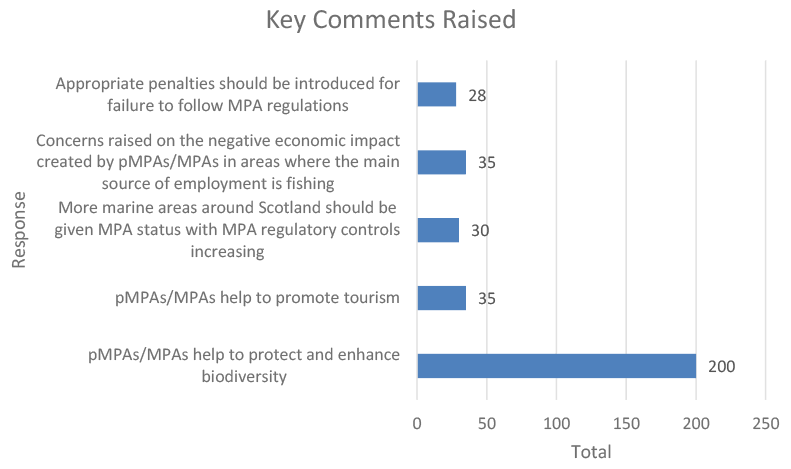
4.4.2. General comments raised
The same methodology in analysing the 1,110 responses was adopted to identify the general comments raised across the five questions.
A summary of the general comments raised in the free text section for the five questions question is provided below:
- 20 responses explained that the pMPA/MPA designations will help to address national, regional and local environmental targets.
- 21 responses outlined that the pMPA/MPA designations would help protect areas from the negative environmental impacts created by fishing.
- 14 responses explained that fishing had taken place in the areas identified for the pMPAs for a significant period of time and has had little or no effects on the environment.
- 10 responses said that the pMPAs/MPAs will fail to discourage the negative environmental impacts created by fishing.
- 12 responses explained that extensive monitoring programmes are required to address the lack of data available to assess the conservation status of features.
A summary of the responses raised above is provided in Figure 4.
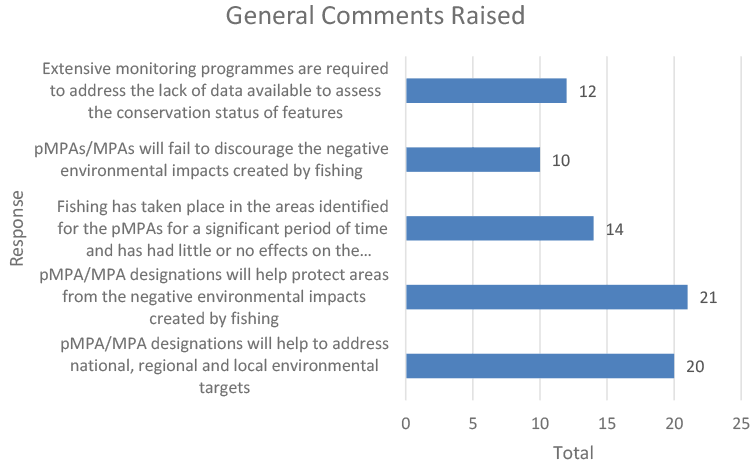
Responses received made supportive comments on the positive effects that the pMPA designation would have on different animals living in the sites. These comments occurred throughout the responses for the five questions.
A summary of the comments is provided in Figure 5.
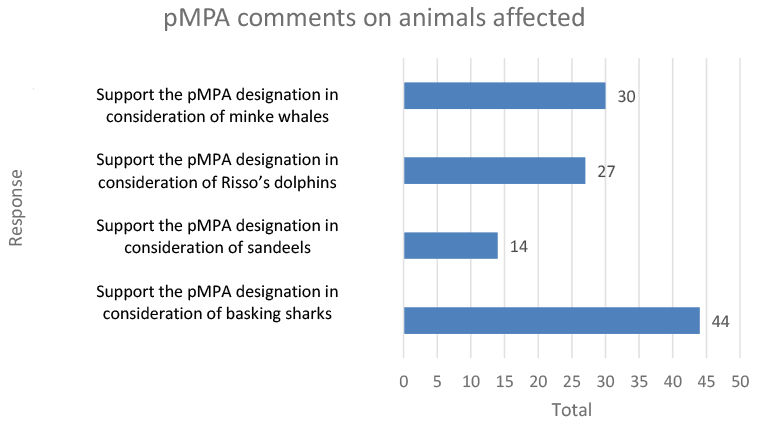
4.4.3. Question One
The comments recorded in this section were the responses received for Question One which asked “Do you support the designation of these possible Marine Protected Areas?”
Links to each of the figures relevant to Question One are contained in Table 8 below.
Table 8 Question One figures
Question One figure references
Figure 6 Question One – support for North-east Lewis
Figure 7 Question One – support for Sea of the Hebrides
Figure 8 Question One – support for Shiant East Bank
Figure 9 Question One – support for Southern Trench
Figure 10 Question One – comparison of support for each site
Figure 11 Question One - respondent category
Figure 12 Question One - academic responses
Figure 13 Question One - aquaculture business/association responses
Figure 14 Question One - community group responses
Figure 15 Question One - energy group responses
Figure 16 Question One - environmental responses
Figure 17 Question One - fishing group or organisation responses
Figure 18 Question One - individual responses
Figure 19 Question One - other business responses
Figure 20 Question One - other industry association responses
Figure 21 Question One - recreation and tourism business/association responses
Figure 22 Question One - regulator or Local Authority responses
Figure 23 Question One - free text comments
Figure 8 to Figure 12 show the responses received for Question One.
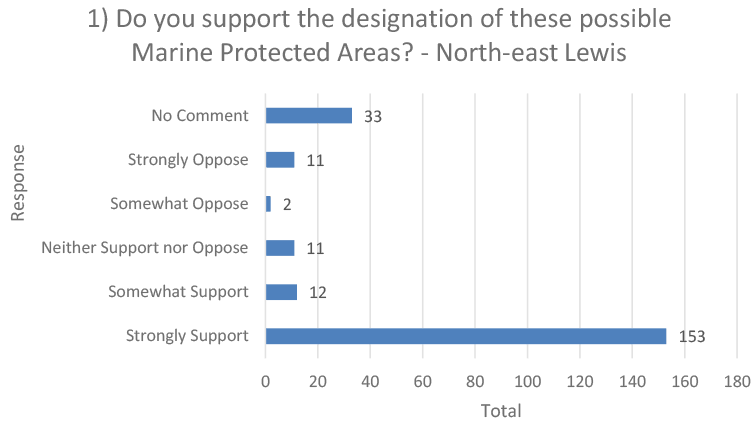
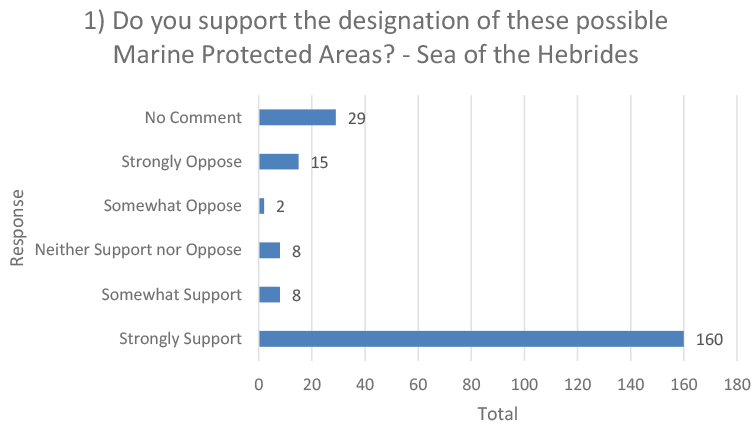
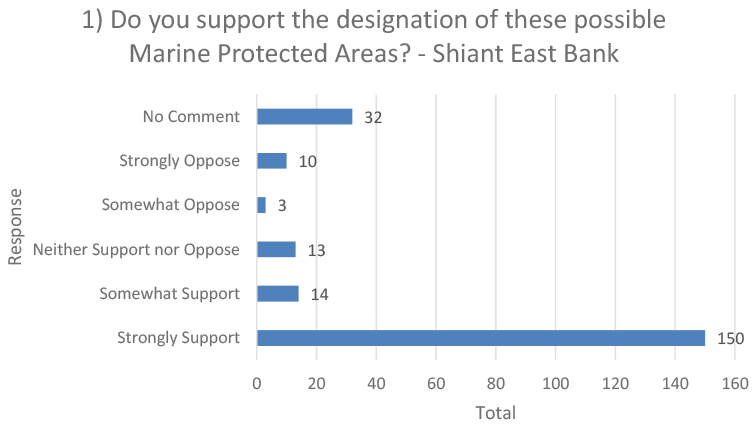
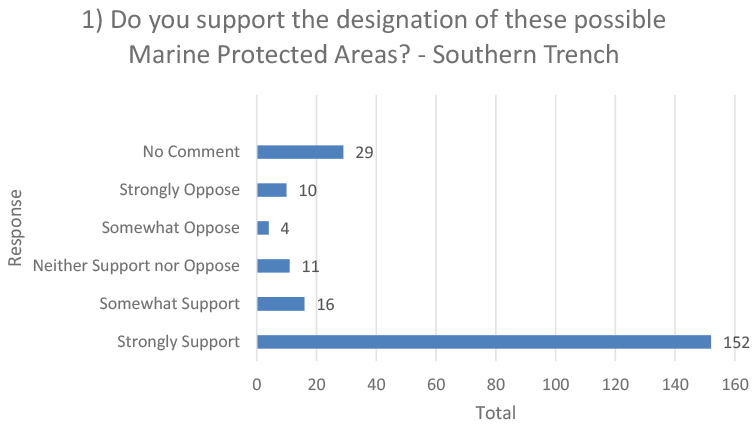
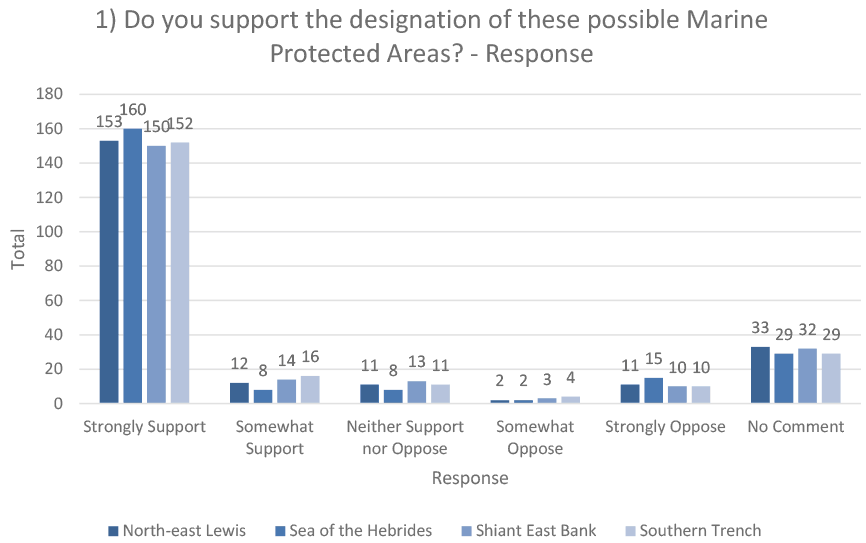
A summary of the answers received for each category of respondent and details of their response are outlined in Figure 13 to Figure 24.
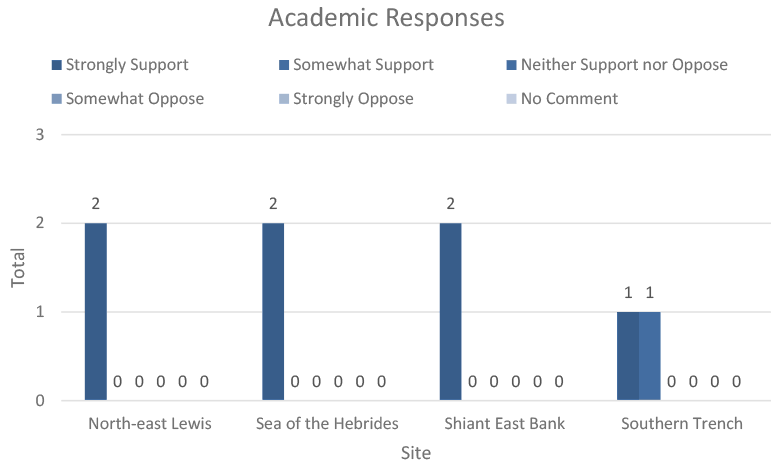
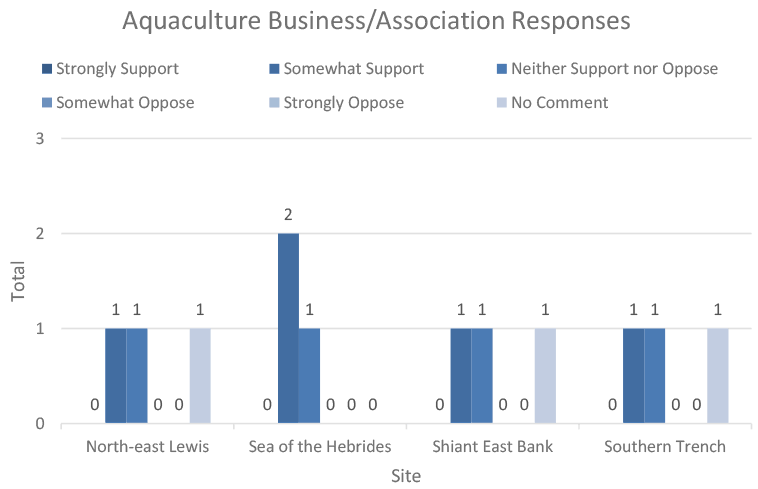
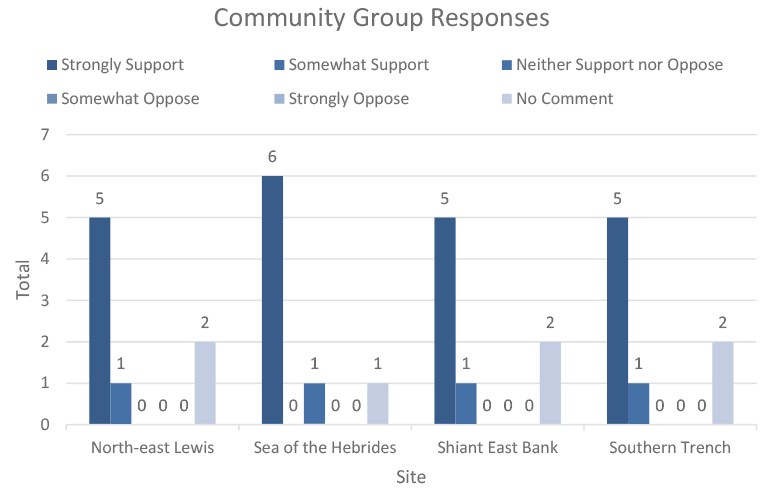
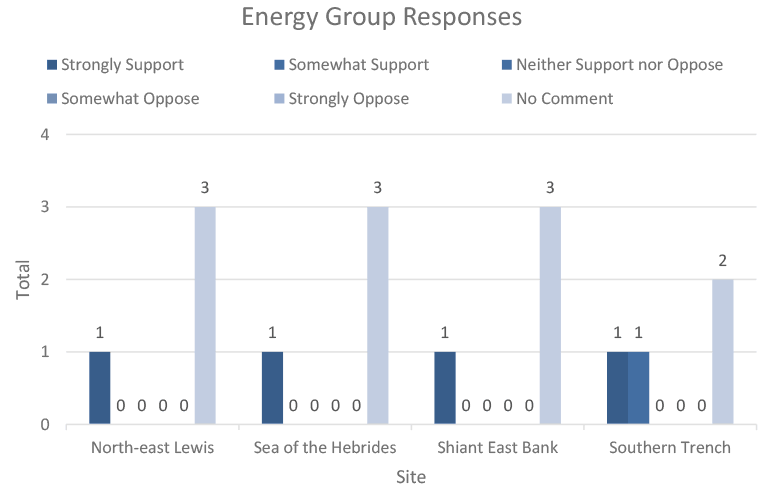
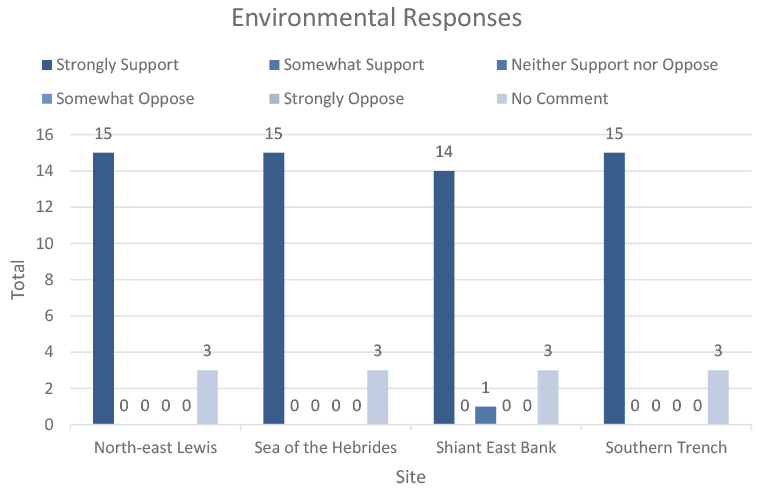
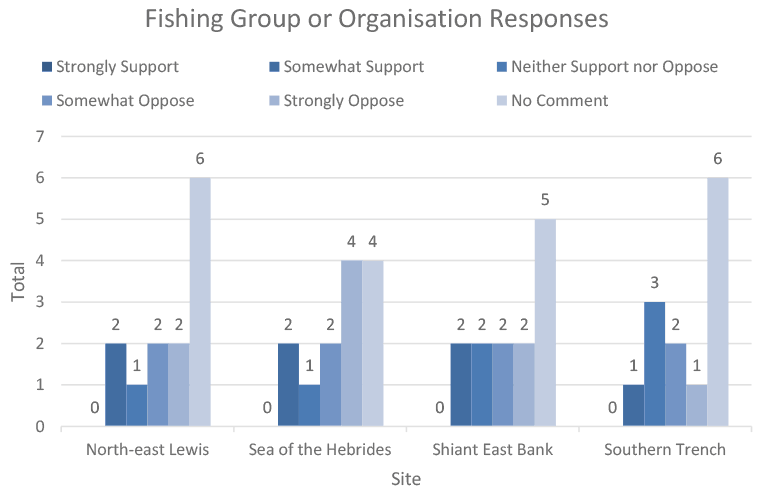
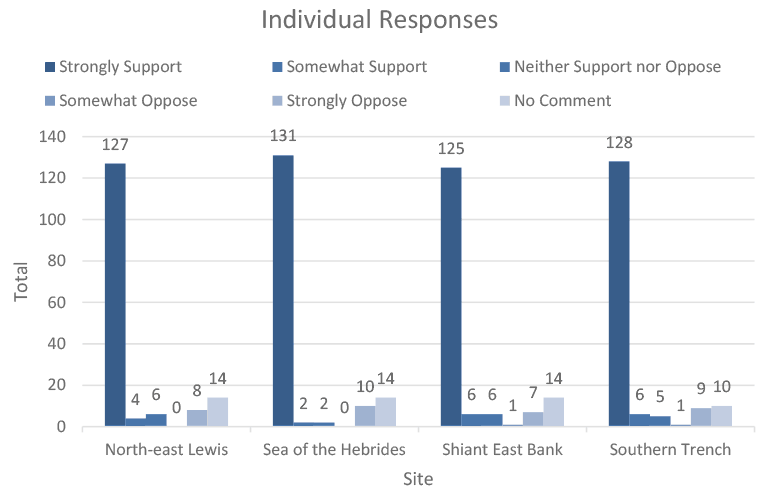
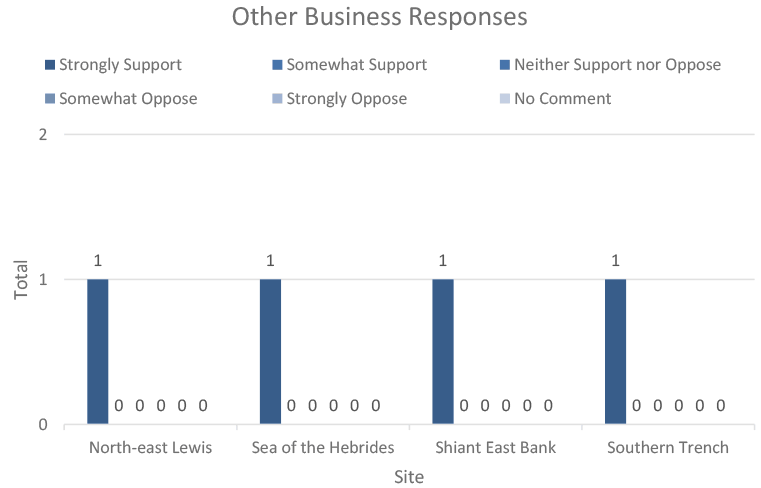
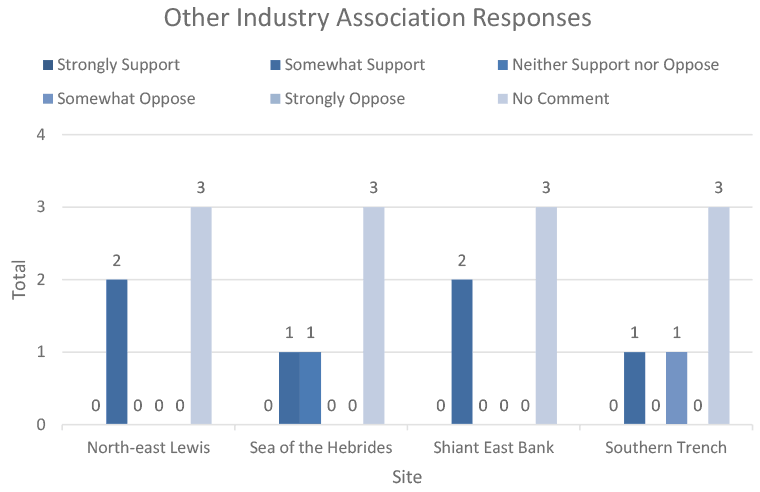
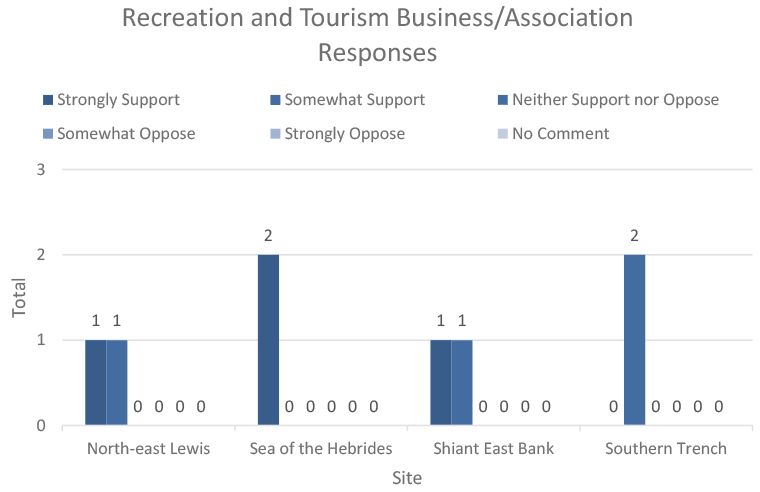
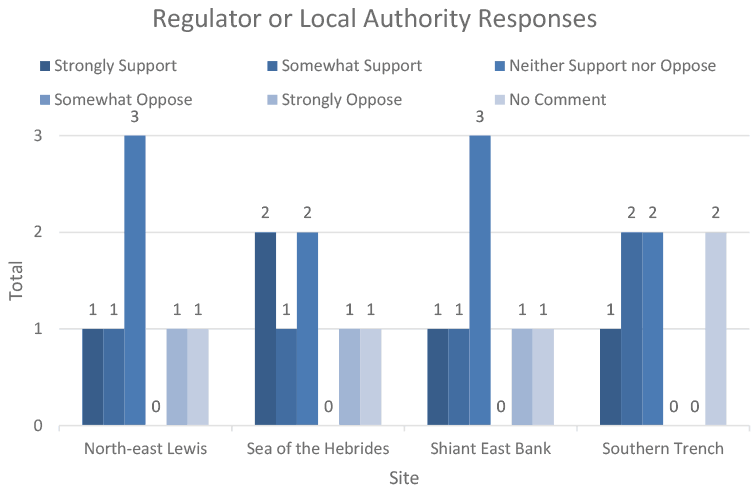

Of the 222 respondents who answered Question One, 157 provided further comments to support their answer.
“These sites are essential to fill known gaps in Scotland’s developing MPA network particularly for mobile species and seabed habitats that are vulnerable to anthropogenic pressures.” (Scottish Environment Link)
Thirteen respondents said that it is important to protect species and seabed habitats that are vulnerable to anthropogenic pressures.
Twelve respondents provided further comment that the pMPAs/MPAs will help to ensure a good quality of life for current and future generations in Scotland.
Five respondents said that the desire to establish a network of MPAs in Scotland is desirable when it is well balanced and well monitored. All five respondents provided further comment that the interests of stakeholders and interested parties in the coastal and sea areas the designations affect should be meaningfully measured.
Three respondents said that the pMPAs/MPAs should form a part of a range of protective measures and policy that ensure species are protected in the waters they inhabit.
Eleven respondents stated that the pMPA/MPA designations would have a negative effect upon the quality of human life.
Ten respondents raised concerns on the employment of fishers in the future.
“Strongly oppose a number of these designated sites to the severe detriment of employment in our already fragile communities.” (Individual)
Five respondents said that fewer or no more marine areas around Scotland should be given MPA status.
Five respondents provided comment that further consideration is required of the impact that MPA designations create on local businesses.
A summary of the comments raised in the free text section for Question One is provided in Figure 23.
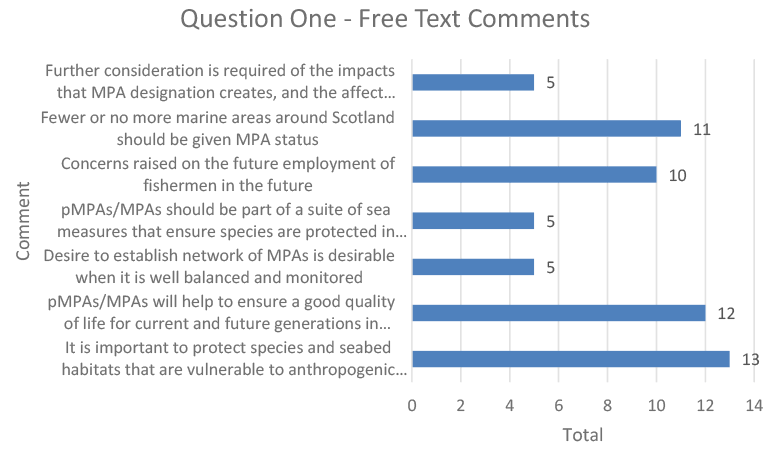
4.4.4. Question Two
The comments recorded in this section were the responses received for Question Two which asked “Do you agree that the scientific evidence presented justifies the case for the designation of each site?”
Links to each of the figures relevant to Question Two are contained in Table 9 below.
Table 9 Question Two Figures
Question Two Figure References
Figure 24 Question Two answers
Figure 25 Scientific evidence comments
Figure 26 Question Two - free text comments
Figure 24 shows the responses received for Question Two.
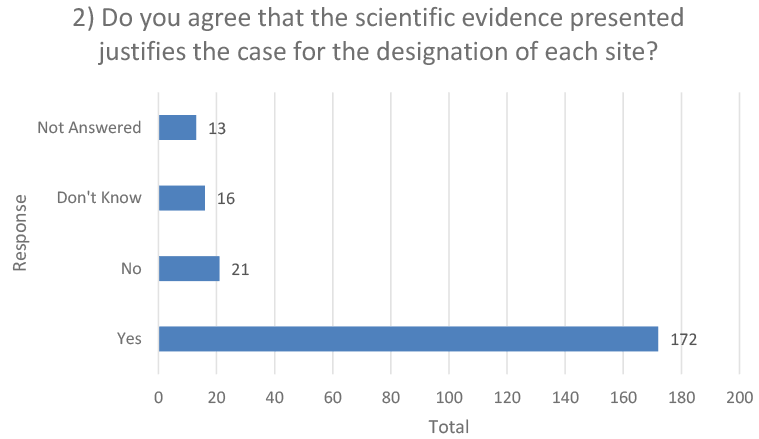
Of the 222 respondents who answered Question Two, 107 provided further comments to support their answer.
Thirty-four respondents explained that they supported the scientific evidence for all the pMPAs or made a general comment in support of the scientific evidence presented.
The number of respondents who supported the scientific evidence to justify the case for the individual pMPAs was two for North-east Lewis pMPA, five for Sea of the Hebrides pMPA and two for Southern Trench pMPA. No comments were received specifically in support of the scientific evidence to justify the case for the Shiant East Bank pMPA.
Nine respondents raised concerns on the scientific evidence presented for all the pMPAs or raised general concerns on the scientific evidence presented.
Two respondents raised concerns of the scientific evidence to justify the North-east Lewis pMPA and two respondents raised concerns of the scientific evidence to justify the Southern Trench pMPA.
No comments were received specifically raising concerns on the Sea of the Hebrides and the Shiant East Bank pMPA.
A summary of the respondents who supported or raised concerns on the scientific evidence for the pMPAs in Question Two is shown in Figure 25.
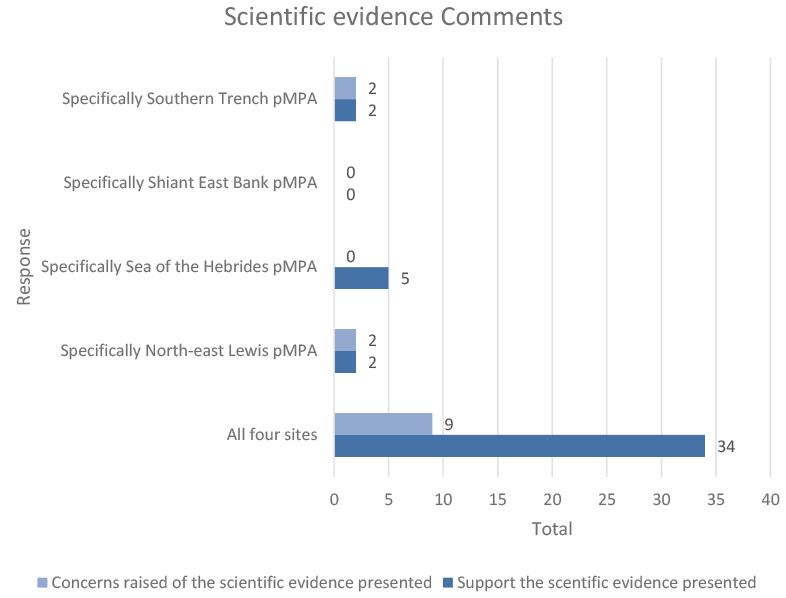
Two respondents provided comment that pMPAs/MPAs will benefit areas where the main source of economy is fishing.
Two respondents provided additional factual information which supports the pMPA designations.
Seven respondents raised concerns that the proposed sites do not extend sufficiently to cover the habitats and species of importance in their vicinity.
“As a result, several large areas of great (apparent) significance, as identified by the habitat modelling work of Paxton et al. (2014), have not been included into the present pMPA proposals, simply because no data are available to effectively confirm their significance.” (Individual)
Three respondents raised comments saying that clarification was required on the effect the pMPAs would have on existing pipelines and the wider oil and gas industry.
Three respondents said that people and communities affected by the pMPA designations should be consulted with now and in the future.
“[Redacted] has always championed the involvement of communities in MPA management. As a community organisation actively involved in collecting data about the [Redacted] and [Redacted], we are pleased to see in these current proposals the acceptance and use of data from other sources such as that collected by coastal communities and other local stakeholders.” (Community Group)
Two respondents reiterated their support for the protection of features identified through a scientific process and commented that any management measures should be relative and appropriate to the features in question. The two respondents provided further comment recommending that scientists work with local fishers to consider natural environmental change in the context of long-term fisheries data.
Two respondents provided additional scientific information in their response to support the scientific evidence presented for this consultation.
Four respondents provided further comment that extensive monitoring programmes are required to address the lack of data available to assess the conservation status of features.
A summary of the key comments raised in the free text section for Question Two is provided in Figure 26.
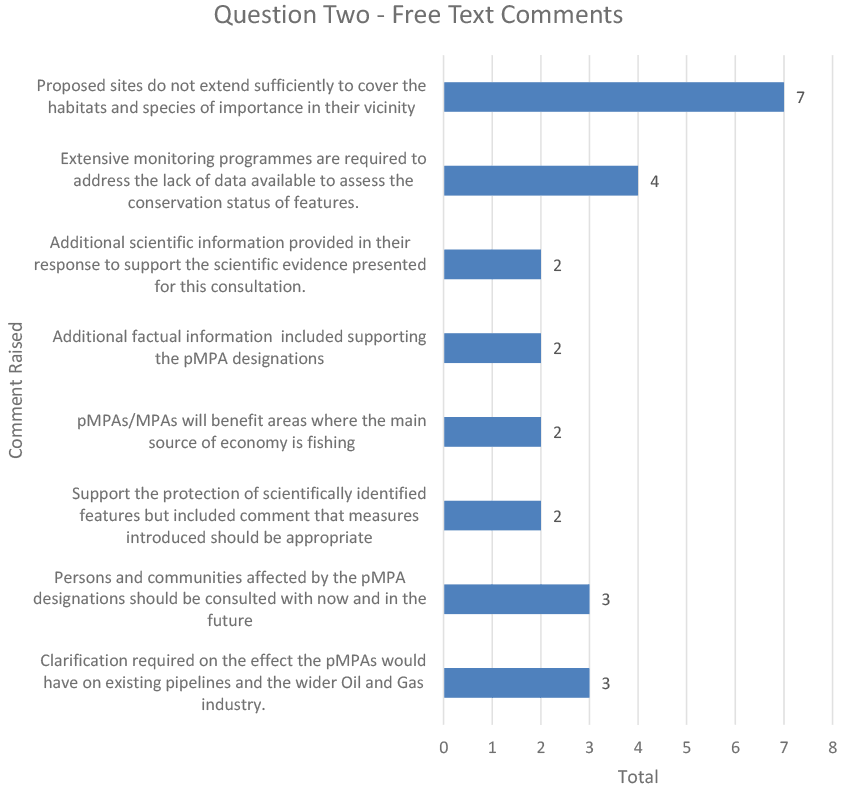
4.4.5. Question Three
The comments recorded in this section were the responses received for Question Three which asked “Do you have any comments on the Conservation and Management Advice for each site?”
Links to each of the figures relevant to Question Three are contained in Table 10.
Table 10 Question Three Figures
Question Three Figures
Figure 27 Question Three answers
Figure 28 Conservation and management advice comments
Figure 29 Question Three - free text comments
Figure 27 shows the responses received for Question Three.
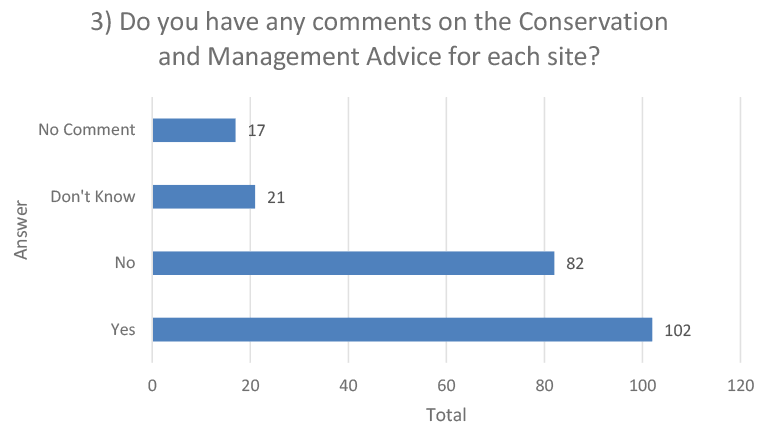
Of the 222 respondents who answered Question Three, 111 provided further comments to support their answer.
A difference was noted between the respondents that answered “Yes” for Question Three (102) and those that actually did provide further comment (111) for the question.
Twenty respondents explained that they supported the Conservation and Management Advice (CMA) for all the pMPAs.
The number of respondents who supported the CMA for the individual pMPAs was five for North-east Lewis pMPA, seven for Sea of the Hebrides pMPA, seven for Shiant East Bank pMPA and seven for Southern Trench pMPA.
Seventeen respondents raised concerns on the CMA for all the pMPAs. The number of respondents who raised specific concerns for the CMA for individual pMPAs was five for North-east Lewis, 12 for Sea of the Hebrides, three for Shiant East Bank pMPA and seven for Southern Trench pMPA . These included comments that the CMA should be stronger or that the Advice and proposals extend too far.
Figure 28 provides a summary of the respondents who supported or raised concerns on the CMA in Question Three.
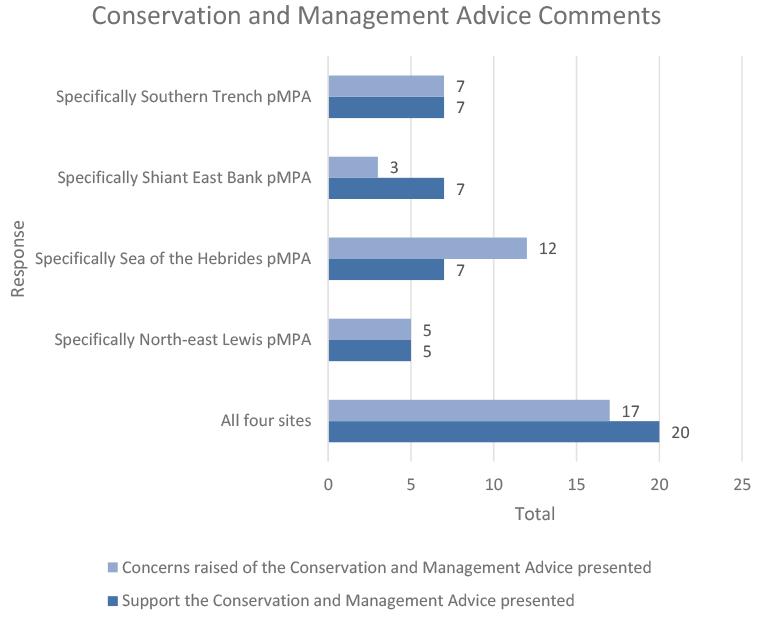
Fourteen respondents said that adequate monitoring and surveillance measures should be introduced to detect any illegal activities in designated sites and appropriate legal action taken upon detection of any infringements.
“A critical component of this is enforcement. In relation to all activity types, clear mechanisms for enforcing restrictions and monitoring compliance are required.” (Environmental)
Eight respondents recommended or requested for the conservation objectives to be changed from ‘conserve’ to ‘recover’.
Six respondents said that an adequate level of monitoring is a high priority for the mobile features in the pMPAs. Activities that need to be considered for management measures in consideration of the mobile species includes vessel traffic, underwater noise, wildlife tourism and mobile and static gear fisheries.
Five respondents made comment that the pMPAs should be included into Scotland’s National and Regional Marine Plans.
Three respondents support the inclusion of management advice for wildlife tour operators.
Four respondents requested clarification as to what ‘Best practice’ is in the context of the different assessments.
Four respondents said that measures to avoid entanglement of mobile species in fishing equipment including fish farm nets, ropes and other gear should be implemented.
Three respondents made further comment that the use of bottom-contacting mobile fishing gear in the pMPAs/MPAs should be banned or restricted.
A summary of the respondent’s comments in the free text section for Question Three are summarised in Figure 29.
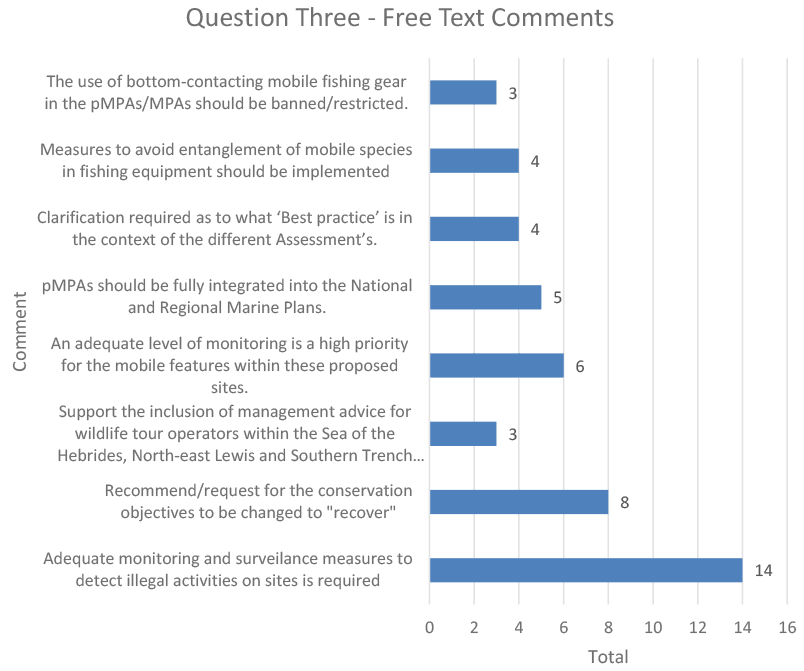
4.4.6. Question Four
The comments recorded in this section were the responses received for Question Four which asked “Do you have any comments on the Business and Regulatory Impact Assessment for each site?”
Links to each of the figures relevant to Question Four are contained in Table 11 below.
Table 11 Question Four Figures
Figure 30 Question Four answers
Figure 31 Business and Regulatory Impact Assessment comment
Figure 32 Question Four - free text comments
Figure 30 shows the responses received for Question Four.
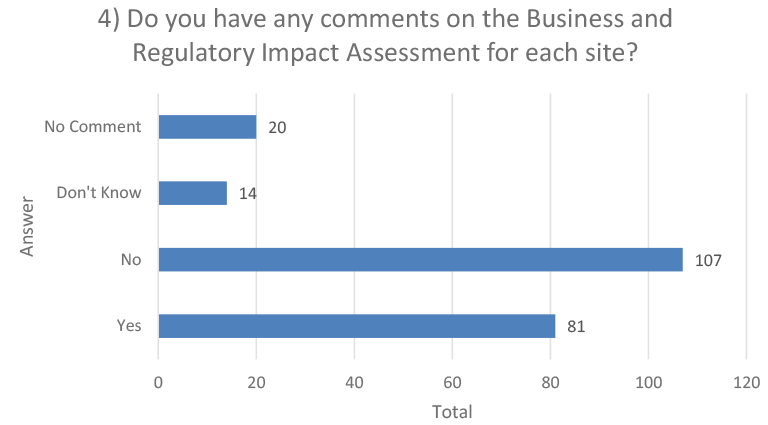
Of the 222 respondents that provided responses for Question Four, 85 provided further comments in the free text section for question four.
A difference was noted between the respondents that answered “Yes” for Question Four (81) and those that did actually provide further comment for the question (85).
Fourteen respondents explained that they support the Business and Regulatory Impact Assessments (BRIAs) for the sites. There was one respondent each in support of the BRIAs for Sea of the Hebrides pMPA, Shiant East Bank pMPA and three in support of the BRIAs for Southern Trench pMPA. No comments were raised specifically supporting the BRIA completed for the North-east Lewis pMPA.
Twenty-nine respondents raised concerns on the BRIAs for all the pMPAs. The number of respondents who raised concerns about the BRIAs for individual pMPAs was three for North-east Lewis pMPA, seven for Sea of the Hebrides pMPA, two for Shiant East Bank pMPA and three for Southern Trench pMPA.
Figure 31 provides a summary of the respondents who supported or raised concerns on the BRIAs in Question Four.
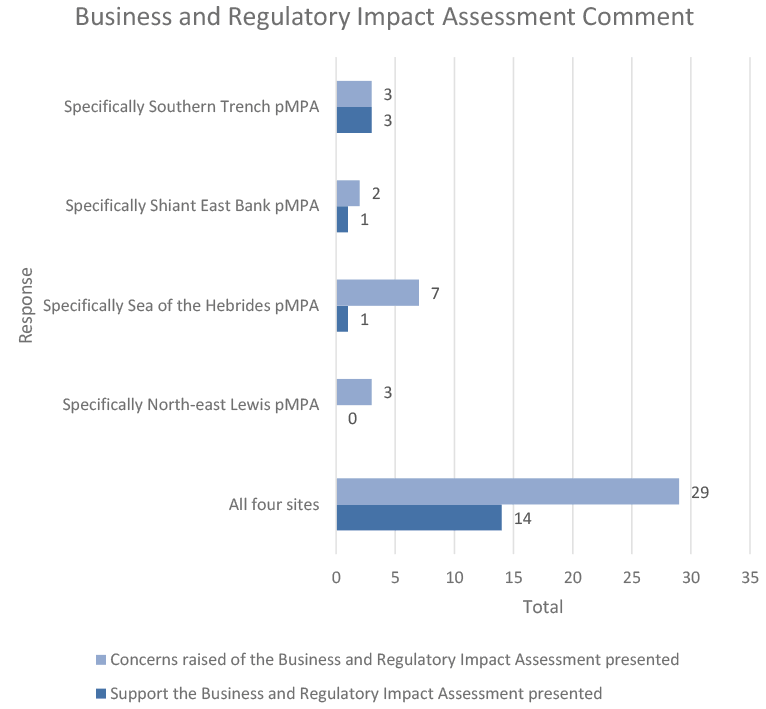
Six respondents made comment that the level and location of reported fishing activity should be confirmed with local fishers through Fisheries Associations.
“The level and location of reported fishing activity should be confirmed with local fishermen through Fisheries Associations.” (Comhairle nan Eilean Siar)
Three respondents provided further comment that scallop dredging should be considered as part of the assessments for the sites.
Two respondents made comment that the cost of displacement of fishing activity is not recognised or is inaccurate.
Many of the comments received from respondents for Question Four were those identified in sections 4.4.1 and 4.4.2.
A summary of the respondent’s comments in the free text section for Question Four are summarised in Figure 32.
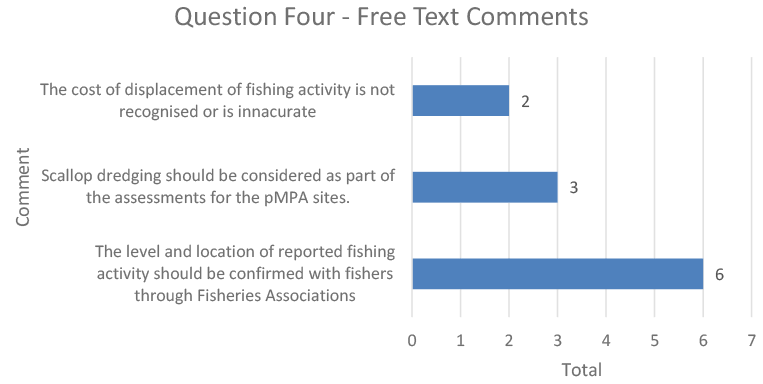
4.4.7. Question Five
The comments recorded in this section were the responses received for Question Five which asked “Do you have any comments on the Sustainability Appraisal, including the Environmental Report and the Socio-Economic Impact Assessment?”
Links to each of the figures relevant to Question Five are contained in Table 12 below.
Table 12 Question Five figures
Figure 33 Question Five answers
Figure 34 Sustainability Appraisal comments
Figure 35 Question Five - free text comments
Figure 33 shows a summary of the responses received for Question Five:
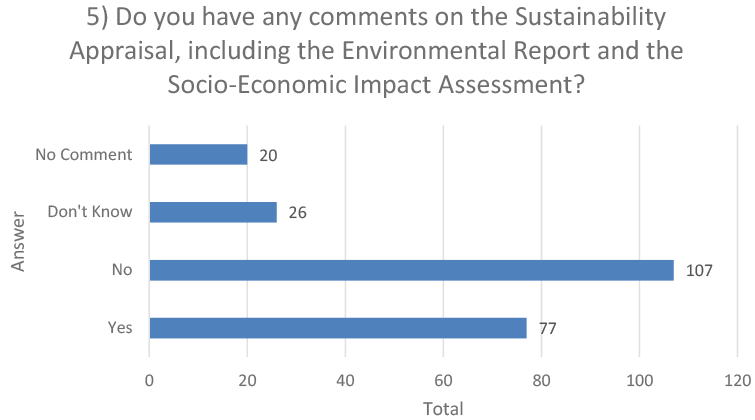
Of the 222 respondents for Question Five, 79 provided further comments in the free text section for the question.
It is thought that the difference between the respondents that answered “Yes” for Question Four (77) and those that did actually provide further comment for the question (79) is a result of respondents not providing the correct response or not understanding the question asked.
Sixteen respondents explained that they support the Sustainability Appraisal for the pMPAs. The number of respondents who specifically supported the elements of the Sustainability Appraisal on individual pMPAs was one for North-east Lewis pMPA, three for Sea of the Hebrides pMPA, one for Shiant East Bank pMPA and one for Southern Trench pMPA.
Twenty-two respondents raised concerns in relation to the Sustainability Appraisal for the pMPAs. The number of comments received relating to specific pMPAs was one for North-east Lewis pMPA, four for Sea of the Hebrides pMPA, one for Shiant East Bank pMPA and one for Southern Trench pMPA.
Figure 34 provides a summary of the respondents who supported or raised concerns of the Sustainability Appraisal in Question Five.
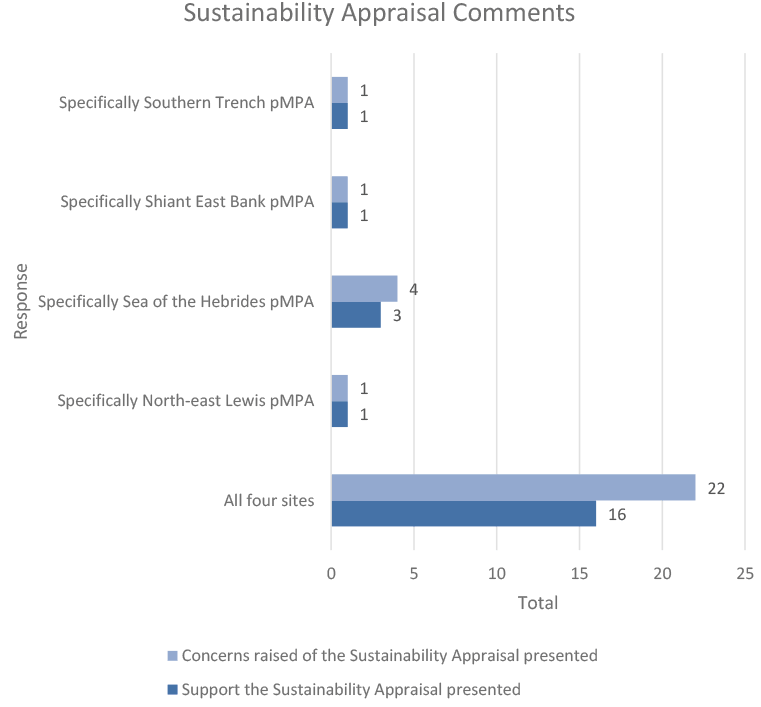
Two respondents provided further comment asking for further information and requesting to speak to someone directly on the pMPA designations.
Two respondents said that the topic of Population and Human Health has been scoped out the Strategic Environmental Assessment (SEA) which may be appropriate at an individual designation level.
Many of the comments received from respondents for Question Five were those identified in sections 4.4.1 and 4.4.2.
A summary of the respondent’s comments in the free text section for Question Five are summarised in Figure 35.
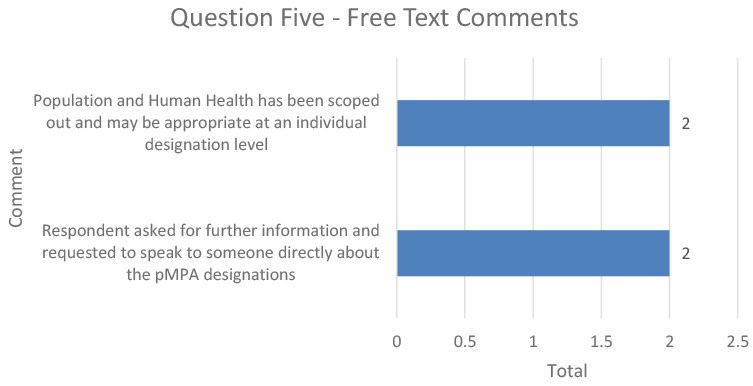
4.5. Key Findings
222 respondents submitted answers and comments for the five questions asked as part of this consultation. Most of the respondents were identified as Individuals (159), but responses were received across the different categories created to identify respondents.
Responses received for the consultation varied significantly in length, detail and technical content.
The key findings have been split in accordance with respondents who raised comment in support or outlined concerns of the pMPAs or MPAs because responses focused on these two areas.
The five topics raised the most in the free text section for each question providing supporting comments of the pMPAs/MPAs were:
- The pMPAs/MPAs help to protect and enhance biodiversity.
- The pMPAs/MPAs help to promote tourism.
- More marine areas around Scotland should be given MPA status or there should be more stringent MPA regulatory controls.
- The pMPAs/MPAs help to address national, regional and local environmental targets.
- The pMPAs and MPAs help to protect areas from the negative environmental effects created by fishing.
The three topics raised the most in the free text section for each question raising concerns of the pMPAs/MPAs were:
- Concerns raised on the negative economic impact that the pMPAs/MPAs will have on areas where the main source of employment is fishing.
- The pMPAs/MPAs will fail to discourage the negative environmental impacts created by fishing.
- Fishing has taken place in these areas for a significant period of time and has had few or no negative effects on biodiversity
Overall a majority of the respondents supported the pMPAs (74%). Respondents realised the positive effect that such designations will have on biodiversity and the tourism industry of the areas that they are located in.
Respondents did raise concerns or opposed the pMPAs (7%). The greatest level of concern was registered in relation to the negative economic impact the pMPAs would have on areas where the main source of employment is fishing.
Contact
Email: marine_conservation@gov.scot
There is a problem
Thanks for your feedback